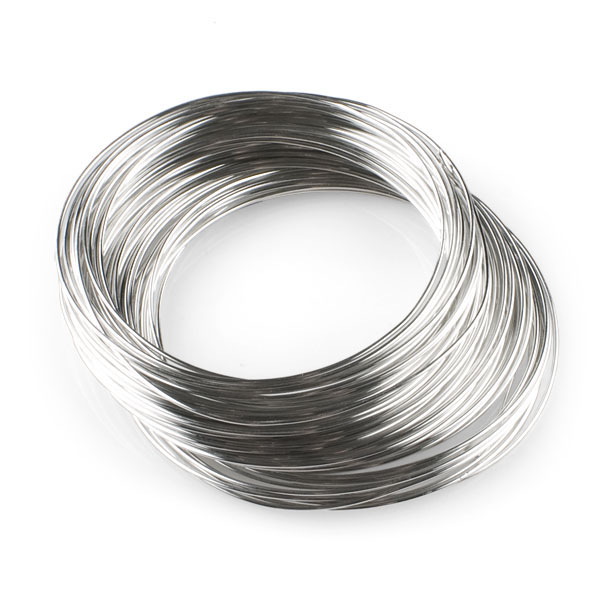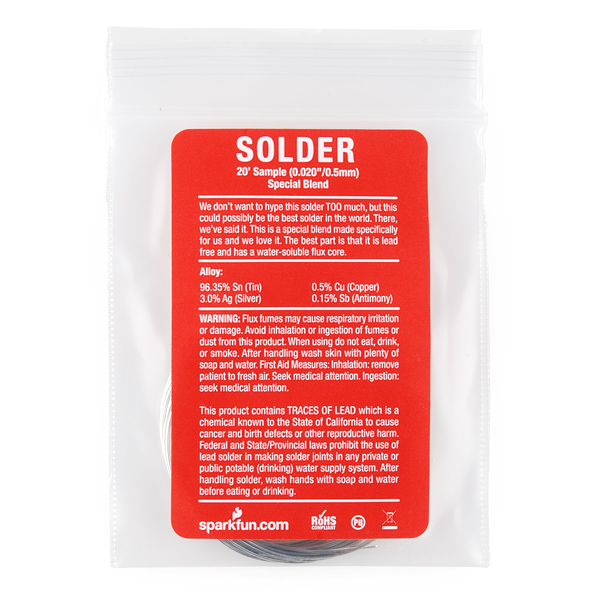Solder - 20' Sample (0.020") Special Blend
We don't want to hype this solder TOO much, but this could possibly be the best solder in the world. There, we've said it. This is a special blend made specifically for us and we love it. It all started as a quest to find the best solder to use in our production process and ended up being the best we've tried. The best part is that it's lead free and has a water-soluble flux core.
This package contains 20 feet of solder and has a diameter of 0.020" (0.5mm).
**Mix: **96.35% Sn (Tin), 3.0% Ag (Silver), 0.5% Cu (Copper), 0.15% Sb (Antimony).
- [MSDS](http://cdn.sparkfun.com/datasheets/Tools/MSDS Indalloy with Fluxcake-301 (CW-301).pdf)
Solder - 20' Sample (0.020") Special Blend Product Help and Resources
Core Skill: Soldering
This skill defines how difficult the soldering is on a particular product. It might be a couple simple solder joints, or require special reflow tools.
Skill Level: Noob - Some basic soldering is required, but it is limited to a just a few pins, basic through-hole soldering, and couple (if any) polarized components. A basic soldering iron is all you should need.
See all skill levels
Comments
Looking for answers to technical questions?
We welcome your comments and suggestions below. However, if you are looking for solutions to technical questions please see our Technical Assistance page.
Customer Reviews
No reviews yet.



What's the melting point for this blend?
Or, asked another way: If I use the SparkFun rework station (http://www.sparkfun.com/products/10706) what would be a good temperature to set it at when using this solder?
Or the Sparkfun Soldering station (https://www.sparkfun.com/products/10707)?
I realize that this is a difficult question to answer, and the number changes based on the size of the components being soldered, but a guideline for appropriate use would be lovely. I'm not an experienced solderer. I've reached that "knows enough to make more interesting mistakes" level of skill, and good data on appropriate temperatures for specific solders is extremely difficult to track down.
To answer my own question,this stuff seems to melt quite nicely at about 375 degrees centigrade. I got the idea from watching the intro video to the Open Tricorder Project (http://www.tricorderproject.org/). It's possible that it'll work fine at some other setting, but behaves how I expect solder to behave when set to 375.
Hey, why is this just as expensive as the 0.032" kind? Since it's thinner but the same length, we'll be getting less solder for our money!
Good point. The regular spools are by weight, so you get a longer length of the thin stuff but the same total volume of solder. Measuring by length means the .032 sample contains about 2.5 times the volume of solder compared to the .020 sample (do the math... the number surprised me too).
The 20' * .032" sample now costs less than this one.
It's more a function of your equipment (iron tip or hot-air nozzle) and technique than the exact width of the solder but yes, this will probably be easier to manage than thicker solder if you use the 'wick' technique. Remember, flux is your friend for surface-mount work - check out the liquid flux pen if you need that critical ingredient.
By my calculations, the mass of this 20-foot sample is about 9.21g. This is taking the densities of the primary constituents, tin and silver, to be about 7365 kg/m^3 and 10490kg/m^3 respectively. By comparison, the 1/4lb mini-spool of this blend is about 131.5g of solder and the 1lb spool accounts for 454g. You can compute the value-for-money quotients on your own.
Moreover, this sample is only 39% the mass of the 0.032" sample for the same price.
Conclusion: If you're thinking about buying this solder blend, pick up the 1/4lb mini-spool instead, as it's 5x better value (as of this writing.)
Ok, I purchased a sample length of this. Still interested in finding an answer to the Antimony question. Is there an MSDS sheet for this?
Anyone? Bueller?
Yay, Sample packs!
Finally, one of my suggestions becomes a product ;)
Do you recommend this thickness for TQFP chips?
Let's be honest, this solder is pretty bad. It simply doesn't stick to solder pads and comes loose. I appreciate the effort to be nature-friendly with the lead free stuff, but this simply doesn't work.
I've been using this solder with Sparkfun soldering station and it flows well with 375C temperature. However, most results look like "disturbed joints" and it leaves, in my perspective, too much flux residue (black leftovers), which is difficult to clean as despite some comments, it doesn't seem to dissolve easily with water, alcohol or even flux cleaner liquid. During soldering, it also creates a lot of fumes. I've recently acquired SAC305 solder, which has exactly same formula, but uses "no clean" rosin core and resulting joints look much smoother (no more "disturbed joints" look), creates considerably less fumes and leaves little to none residue (which, if any, does seem to go away with alcohol easily). Therefore, I think the problem is the flux used in this blend.
I looked up a similar formula on wikipedia and the melting point is 217-225 centigrade (Ag03A. Patented by AIM alliance.). The components and board soldered do not control the melting point of the solder, only the amount of power need to get to that melting point. Small components to tiny board, not much power. Large connector to big lug will take lots of wattage.
This solder is will make you take the components to a higher temperature to melt, possible damage to board or components, and may not be eutectic. That means that rather than go from liquid to solid in a very small variation of temperature, as 63/37 lead solder does, it will be in a plastic state longer.This allows for the movement of the solder joint to create cold solder fractures, a cold solder joint. That is a bad connection characterized by a mottled or wrinkled appearance to cracks you can see in the solder joint. A good solder joint should be shiny.
Choose the lowest melting point solder to use and the smallest diameter. Small components with small holes = small diameter. Large lug connecting to large gauge wire or lead = large diameter solder.
You should have a special need to use exotic formulas of solder.
Hope this is helpful. :)
It would be awesome if this came in a tube like the small quantity silver solder kester sells.
i couldnt melt this solder with a 30watt radioshack gun? it only turned to wet paste, have no problems with lead 62/36/2 silver bearing solder, thought that was weird! what do you guys think?
FYI I almost destroyed my board trying to use this solder with your TOL-09507 30W iron. Granted I'm just now picking up soldering again but after hopping down to RadioShack to get some old fashioned lead-based 60/40 solder, I completed my project in no time.
I suspect you need a classy soldering iron when you use classy solder :)
62/36/2 is still more than a third lead :) This solder definitely needs a higher temperature. One commenter above mentioned 375°C (~705°F), my temperature-controlled station only does steps of 20 so I've got mine set to 380°C (~715°F) and it flows quite nicely. Trying it at home with my old Weller (no temperature control and pretty much from the age of 60/40), on the other hand, it's just a slusheous puttylicious mess that is almost completely unworkable.
I don't know what temperature your 30W radioshack gun gets to - keep also in mind that wattage may not be related to temperature (it only tends to be so in 'dumb' soldering irons, in which case one youtube video would suggest a 40W would be more inclined to keep the desired temperature than a 25W one).
thanks man, thats what i thought, i'm saving up on a hakko, been using that radioahck gun for years and i go through tips like crazy, the hakko will pay for its self in tip saving alone
A water soluble flux core is easier to clean off (because you just use water!) but it is bad news if you leave it on the circuit board after soldering. It can cause corrosion over time which is less than entirely desirable in most cases :) You don't need to soak it (nor do I recommend that :) just use a paintbrush or Q tip wet with water and wipe off the solder joints.
Melting point??? pls?
This stuff is nice. I just finished my first ever soldering project.
What is the purpose of the Antimony in this?
It improves the workability and strength of the solder, doing what lead did in older, more toxic solders.
Is this solder better than other?
http://www.sparkfun.com/products/9325
Why give away the secret recipe?
Because we're SparkFun, there are no secrets.
If I'm in a country where I can buy and use leaded solder(ie, USA, only hobby use) then is there any real reason to buy an unleaded solder? I'm just curious about this one because of how Sparkfun seems to think its the best solder ever. Is it the best solder ever, or the best unleaded solder ever?
The reason is lead-free solder is less toxic, so you won't get lead in the landfill when you could be using the lead that went in to the leaded kind for stuff like radiation shielding, toxicity bombs (just kidding), etc.
I'm considering trying out this solder but I have a couple of questions -
1) Is it easier to use than the stuff with a higher percentage of Antimony? I've had bad luck with cold solder joints on another brand of lead free solder.
2) Is it safe to handle with bare hands? Antimony is pretty toxic, right up there with arsenic, but I don't know about a product with a .15% percentage of it, and whether it's less toxic when when it's bound to other elements in the product.
Thanks
Any human that isn't a developing child, or an immune system deficient (elderly or other issues) can easily handle LEAD, MERCURY, and other poisons. Humans are way more resilient than you'd normally think. But only in the middle spectrum, not the ends of the age window.
Just wash your hands afterwards and you'll be fine. I've handled LEAD BASED solder with my bare hands and I just washed my hands afterwards. Ain't suffered no ill effects. You'd probably have to hold the solder in your mouth to be poisoned by anything that's in it. That would probably be worse with lead solder, but who would put solder of any kind, or wires for that matter, into their mouth? Remember, lead based solder is usually something like 40% or 37% lead, but there's only 0.15% antimony in this. Do the math.
I asked in feedback, and John said:
Yeah, I wanna know! (EDIT: I (EDIT: don't need to know) REALLY wanna know!!! NOW!!!) If it's non-toxic enough, then I might not be scared of soldering anymore!
SOMEONE TELL ME ALREADY!!!!!!!!!!!!1!!1!111!!!!!!!1!!!11!!!!!!!!!!!!!!!!!!!!!!!!!!!!!!!!!!!!!!!!!!!!!!!!!!!!!!!!!!!!!!!!!!!!!!!!!!!!!!!!!!!!!!!!!!!!!!!!!!!!!!!!!!!!!!!!!!!!!!!!!!!!!!!!!!!!!!!!!!11111!!!!!!!!!!!!!!!!!!!!!!!!!!!!!!!!!!!!!!!!!!1111!!!!!!!!!!!!!!!!!!!!!!!1!!!!!!!!!!!!!!!!!!!!!!!!!!!!!!!!!!!!!!!!!!!!!!!!!!!!!!!!!!!!!!!!!!!!!!!!!!!!!!!!!!!!!!!
Bill. Chill.
Both of you can email techsupport@sparkfun.com. If you've had cold solder joints, it's probably a combination of technique, your iron, and the solder. This stuff is boss, it should eliminate the solder issue at least.
I handle it all the time, and my third arm just barely hurts. But seriously, it's not toxic to handle.
Formatting error GET!